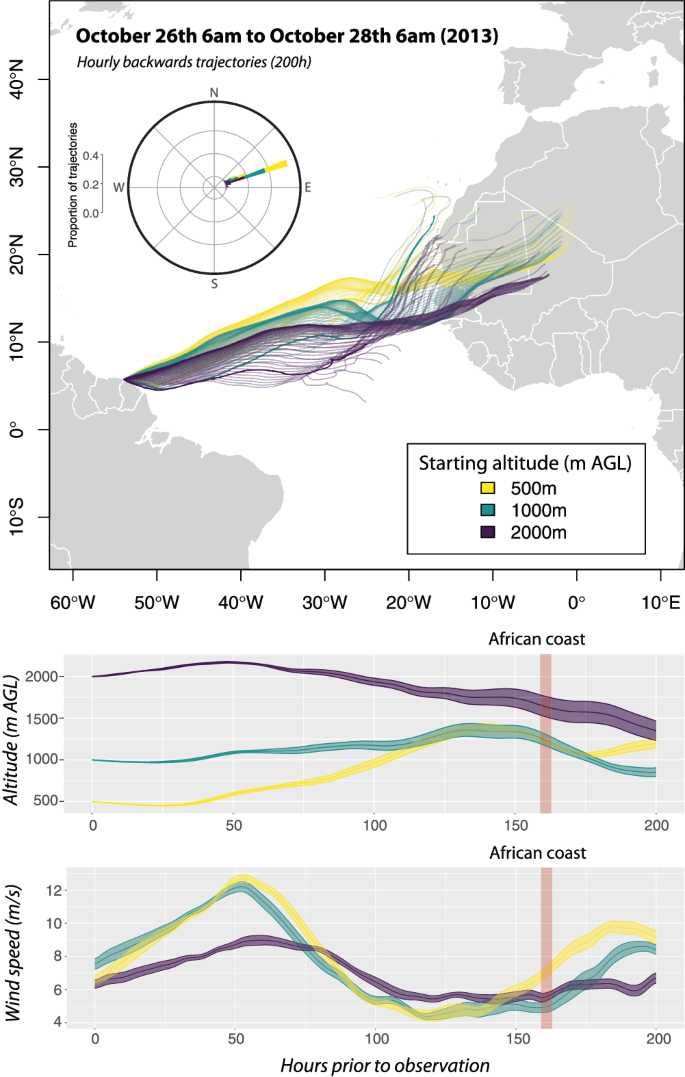Welcome to DU!
The truly grassroots left-of-center political community where regular people, not algorithms, drive the discussions and set the standards.
Join the community:
Create a free account
Support DU (and get rid of ads!):
Become a Star Member
Latest Breaking News
Editorials & Other Articles
General Discussion
The DU Lounge
All Forums
Issue Forums
Culture Forums
Alliance Forums
Region Forums
Support Forums
Help & Search
Good News
Related: About this forumƸ̵̡Ӝ̵̨̄Ʒ Painted Lady Flutterbys Fly Across the Atlantic: Warmly Inspiring Ƹ̵̡Ӝ̵̨̄Ʒ
"Flutterbys" being what I'm told I called such bright, flying, magical creatures as a child Ƹ̵̡Ӝ̵̨̄Ʒ Ƹ̵̡Ӝ̵̨̄Ʒ Ƹ̵̡Ӝ̵̨̄Ʒ

Painted lady butterflies (Vanessa cardui) aren’t exactly strangers to long journeys across land, but for the first time ever, scientists have shown they’re also capable of making non-stop flights across oceans, having mapped the insects migrating a whopping 4,200 kilometers (2,610 miles) across the Atlantic.
The first indication of these transatlantic flights came back in October 2013, when researcher Gerard Talavera spotted several painted lady butterflies on a beach in French Guiana. Those that were found alive were visibly resting and all had damage to their wings, but that wasn’t what was unusual – these butterflies aren’t normally found in South America...
DNA testing first showed the specimens on the beach were related to populations in Europe and Africa, ruling out the team’s initial theory that the butterflies had come from North America, the nearest place they are typically found...
It turns out that in the time preceding the discovery of the butterflies in French Guiana, there had been sustained, favorable wind currents from Africa across the Atlantic. This meant that the butterflies would’ve been able to make a non-stop journey over the ocean in around five to eight days; without the winds, they’d only have lasted around 780 kilometers (485 miles)....
https://www.iflscience.com/world-first-evidence-shows-butterflies-can-fly-over-4000-kilometers-across-the-atlantic-ocean-74837
The first indication of these transatlantic flights came back in October 2013, when researcher Gerard Talavera spotted several painted lady butterflies on a beach in French Guiana. Those that were found alive were visibly resting and all had damage to their wings, but that wasn’t what was unusual – these butterflies aren’t normally found in South America...
DNA testing first showed the specimens on the beach were related to populations in Europe and Africa, ruling out the team’s initial theory that the butterflies had come from North America, the nearest place they are typically found...
It turns out that in the time preceding the discovery of the butterflies in French Guiana, there had been sustained, favorable wind currents from Africa across the Atlantic. This meant that the butterflies would’ve been able to make a non-stop journey over the ocean in around five to eight days; without the winds, they’d only have lasted around 780 kilometers (485 miles)....
https://www.iflscience.com/world-first-evidence-shows-butterflies-can-fly-over-4000-kilometers-across-the-atlantic-ocean-74837

Here's a bit of information about Painted Ladies from an "Okanogan Country" (Okanogan River Valley) tourism website
Nearly everybody has heard of the amazing migrations of the Monarch butterflies. But there is another butterfly that is a phenomenal migrator – Painted Lady butterflies.
Painted Lady butterflies are found throughout the world. In the Western U.S. they begin their migration in the Southwest and can fly as fast as 30 mph at 6-12 feet above ground traveling up to 100 miles per day...I found them very difficult to capture as they seemed to rarely land and only momentarily.
https://okanogancountry.com/story/painted-lady--butterfly-of-the-month
Painted Lady butterflies are found throughout the world. In the Western U.S. they begin their migration in the Southwest and can fly as fast as 30 mph at 6-12 feet above ground traveling up to 100 miles per day...I found them very difficult to capture as they seemed to rarely land and only momentarily.
https://okanogancountry.com/story/painted-lady--butterfly-of-the-month
This is the abstract of the open source Nature article "A trans-oceanic flight of over 4,200 km by painted lady butterflies" which was the basis for the IFLScience piece which caught my eye this morning, and which brightened my day and which I hoped might help brighten that of others—really, if a butterfly can cross the Atlantic...
The extent of aerial flows of insects circulating around the planet and their impact on ecosystems and biogeography remain enigmatic because of methodological challenges. Here we report a transatlantic crossing by Vanessa cardui butterflies spanning at least 4200 km, from West Africa to South America (French Guiana) and lasting between 5 and 8 days. Even more, we infer a likely natal origin for these individuals in Western Europe, and the journey Europe-Africa-South America could expand to 7000 km or more. This discovery was possible through an integrative approach, including coastal field surveys, wind trajectory modelling, genomics, pollen metabarcoding, ecological niche modelling, and multi-isotope geolocation of natal origins. The overall journey, which was energetically feasible only if assisted by winds, is among the longest documented for individual insects, and potentially the first verified transatlantic crossing. Our findings suggest that we may be underestimating transoceanic dispersal in insects and highlight the importance of aerial highways connecting continents by trade winds.
https://www.nature.com/articles/s41467-024-49079-2
https://www.nature.com/articles/s41467-024-49079-2

It is strange to me that—perhaps representing the hesitancy of many scientists to go beyond the immediate study results—no mention is made (unless I simply missed it) of what became of these intrepid little beings after reaching shore in the New World.
South America has its own population of V. cardui. Did the migrants intermingle with these, or did they simply perish after such a long and dangerous journey? One hopes it had an ending such as Shakespeare wrote in Twelfth Night:
Trip no further, pretty sweeting,
Journeys end in lovers’ meeting—
Ƹ̵̡Ӝ̵̨̄Ʒ Ƹ̵̡Ӝ̵̨̄Ʒ